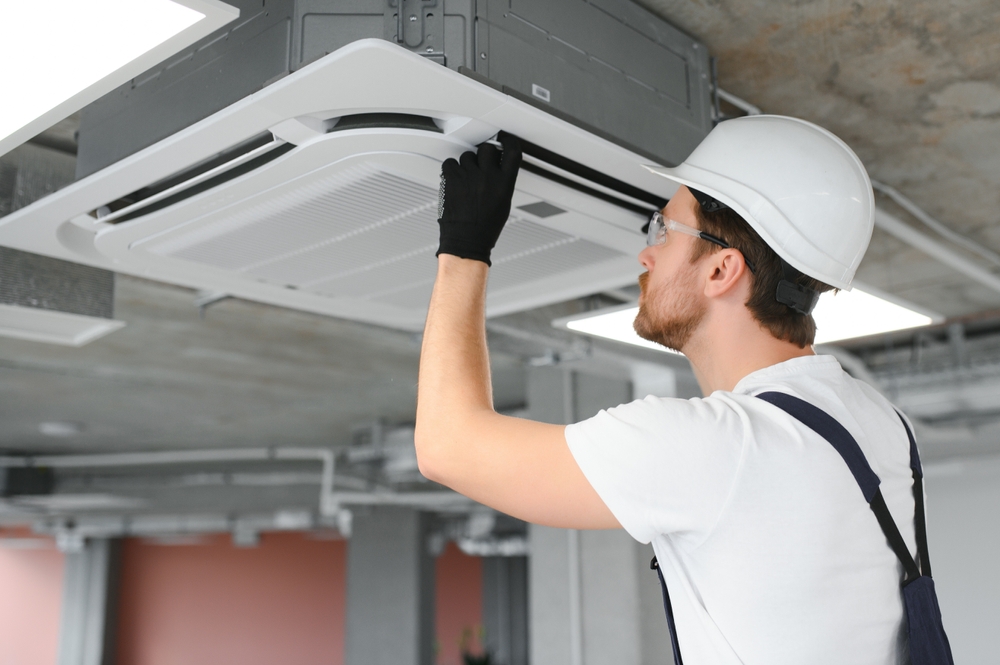When it comes to running a data center or server room, one of the most important pieces of equipment is the computer room air conditioner (CRAC).
These units are specifically designed to maintain a consistent humidity level and temperature, making sure that the sensitive electronics in the room remain operational.
So, how exactly do CRACs work?
At their most basic level, these units operate similarly to a standard air conditioning system, with a few key differences.
Let’s take a closer look at the components and operation of a CRAC:
Components of Computer Room Air Conditioners
A computer room air conditioning (CRAC) unit is a complex system that consists of several key components that work together to regulate the temperature and humidity levels in a data center or other electronic equipment room.
Each component plays an important role in the system’s operation:
- Compressor: This component compresses the refrigerant, which then moves through the rest of the system. This process raises the pressure and temperature of the refrigerant, making it capable of absorbing any heat from the air that passes over the evaporator coil.
- Evaporator: The evaporator is responsible for removing heat from the air as it passes over the cold coils. The refrigerant, which has been regulated by the expansion valve, flows through the evaporator coil. This helps to lower the temperature of the room.
- Condenser: The refrigerant flows through a coil inside the condenser, and the heat that it has absorbed from the air is released. The condenser releases the heat that has been removed from the air, typically through an outdoor unit or a water-cooled system.
- Expansion valve: This valve helps to regulate the flow of refrigerant through the system, ensuring that the right amount is being used at any given time. This helps to improve the efficiency of the system and reduce energy consumption.
- Fans: Fans are used to move air over the evaporator and condenser coils, helping to facilitate heat transfer. This improves the efficiency of the system and ensures that the heat exchange process is effective.
- Sensors and controls: These components are responsible for monitoring the temperature and humidity levels in the room and adjusting the system as needed. The sensors provide feedback to the control system, which then adjusts the CRAC unit to maintain the desired temperature and humidity levels.
- Humidifier: This component adds moisture to the air to reduce static discharge in the room. The humidifier uses ultrasonic or heating elements to vapourize the water. It is controlled by the humidity sensor.
The Types of Computer Room Air Conditioners
There are several different types of CRACs available, each of which is designed to meet the specific needs of different types of data centers and server rooms. Let’s take a look at some of the most common types:
Air-Cooled CRACs
These units use air to cool the refrigerant, which is then circulated through the system.
They are typically less expensive and easier to install than other types of CRACs, but they may not be suitable for larger or high-density server rooms.
Water-Cooled CRACs
In a water-cooled CRAC unit, water cools the refrigerant, which is then circulated through the system.
They are typically more efficient than air-cooled units, but they require access to a reliable source of water and can be more expensive to install.
Glycol-Cooled CRACs
Similar to water-cooled units, glycol-cooled CRACs use a mixture of glycol and water to cool the refrigerant.
This can be a good option for data centers or server rooms that require precise temperature and humidity control.
In-Row Cooling
In-row cooling units are designed to be installed in between server racks, providing targeted cooling where it is needed most.
They can be more efficient than traditional CRACs since they only cool the areas that need it.
Chilled Water Systems
Chilled water systems use a network of pipes to circulate chilled water throughout the data center or server room. The cold water is then used to cool the air, which is circulated through the space.
These systems can be highly efficient, but they require a significant amount of infrastructure to install.
Maintaining Your Computer Room Air Conditioner

Proper maintenance is essential for ensuring the efficiency and effectiveness of your computer room air conditioner (CRAC).
Not keeping up with regular maintenance can result in reduced performance, increased operating costs, and even equipment failure.
To ensure your CRAC operates at optimal levels, here are some tips to keep in mind:
- Change air filters regularly: Dirty air filters can restrict airflow, reducing the efficiency of your CRAC. It’s important to change the air filters every three to six months or more frequently if the environment is particularly dusty.
- Keep coils clean: Dirty coils can also restrict airflow, so it’s important to keep them clean. You may need to have them professionally cleaned periodically to prevent dust and debris buildup.
- Monitor refrigerant levels: Low refrigerant levels can affect the cooling capacity of your CRAC. Make sure to monitor refrigerant levels regularly and repair leaks as needed to ensure your CRAC is operating efficiently.
- Check for leaks: Leaks in your CRAC’s refrigerant system can lead to reduced efficiency and increased operating costs. Regularly check for leaks and have them repaired promptly to avoid further damage.
- Schedule regular maintenance: Ideally, you should have your CRAC serviced by a professional at least once a year. Professional maintenance can help identify potential issues before they become major problems, ensuring your CRAC is running at optimal levels.
By following these maintenance tips, you can ensure your CRAC is operating efficiently and effectively, providing the necessary cooling to keep your critical equipment running smoothly.
Computer Room Air Conditioning Solutions
A computer room air conditioner is an essential piece of equipment for any data centre or server room.
By understanding how these units work and how to maintain them properly, you can ensure that your critical equipment is kept in optimal condition.
If you are in need of reliable and efficient computer room air conditioning services, look no further than Advantage Refrigeration.
Contact us today to learn more about our computer room air conditioning solutions and how we can help you keep your data center or server room operating at peak efficiency.






















